How to travel in Canada
This section helps you to learn about all the different ways to travel in Canada. You decide what fits you best. After all, how you like to travel depends on your own personal taste.
Which of these options do you prefer?
Type of travel
Organization level
Comfort level
Travelling by road in Canada
Canada is a wonderful country to discover for yourself, at your own pace, from behind the wheel of a car or a recreational vehicle (RV).
You may not want to drive across the whole country – that could take from a week to a month, depending on how hard you push yourself. But there are plenty of amazingly scenic road trips you can take in all parts of Canada.
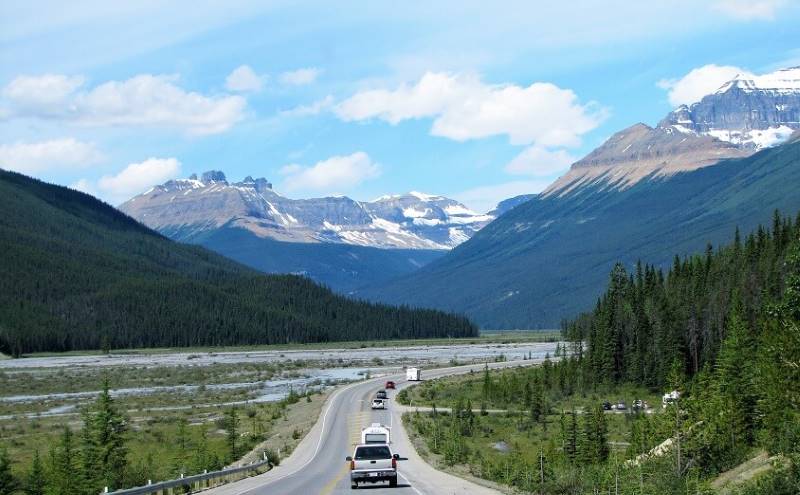
Canada is a great for a road trip!
Travelling by train in Canada
All aboard! The coolest way to travel in Canada is by train.
There’s no better way to appreciate the diversity of Canadian scenery and landscape than by viewing it from a train window.
View my Train Travel in Canada page
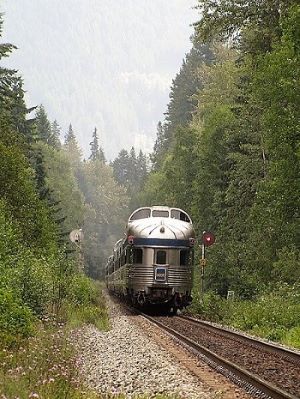
via rail train
Travelling by bus in Canada
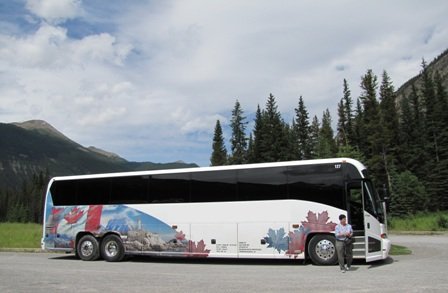
group travel by motor coach
The bus is a North American institution – one of the most comfortable and economical ways to travel in a big country. Here are just a few of the many advantages:
- Instead of driving, you can just sit back, relax, and enjoy the scenery.
- You may even see some wildlife from the big windows.
- The on-board washrooms mean you don’t ever have to grit your teeth until the next pit stop (or beg the driver to stop the bus so you can find a bush to go behind!)
- The experienced drivers know the route, and the best places to stop
- If there’s a tour guide, he or she gives interesting information (and takes care of the trip logistics)
- It’s the more carbon-friendly travel option.
For more on travelling by tour bus or coach, view my Coach Tours Canada page.
Travelling with a group in Canada
Group travel tours have many advantages.
- You can let somebody else make all the decisions and do all the thinking, while you relax and share your experiences with fellow passengers.
- Travel groups often consist of people who share the same interests, so the laughs and friendships that may result definitely add to your enjoyment.
- And while you have fun, you also save money and reduce your carbon footprint.
View my Group Travel in Canada page.
Like everything else in life, there are some upsides and some downsides to “going solo” and making your own plans.
Here are some of the pros and cons:
- You can go wherever you like, whenever you like – with nobody to please but yourself.
- It’s part of the fun to prepare for your own journey. With one of my roadbooks planning will be a peace of cake!
- Planning your trip increases your knowledge of your destination.
- It takes a lot of time to successfully organize a trip – and many people are stressed for time. My roadbooks will be of great help!
- Many accommodations and activities need to be booked well in advance, especially during the high season. Even simple activities, like camping in National or Provincial Parks, need lots of planning – especially if you want to book a favourite spot. Popular destinations fill up fast, so you have to act as soon as you know when and where you want to go.
- If safety is a concern for you, group travel is a safer way to enjoy your Canadian vacation.
Organized travel in Canada
Many people think of organized travel as being more expensive, but that’s not always the case. Often travel agents can get better prices for lodging and activities because they buy in bulk. However, sometimes you do have to pay agents an additional fee for organizing your vacation.
Here are some other things you might want to consider:
- If you find it a burden to plan your own trip, or if you just don’t have the time, booking an organized tour can make good sense.
- Your agent takes care of the details, and the trip is guaranteed to have a few highlights.
- Travel agents usually offer a choice of individual packages or group tours. These can be great fun, and offer you the chance to meet interesting new people.
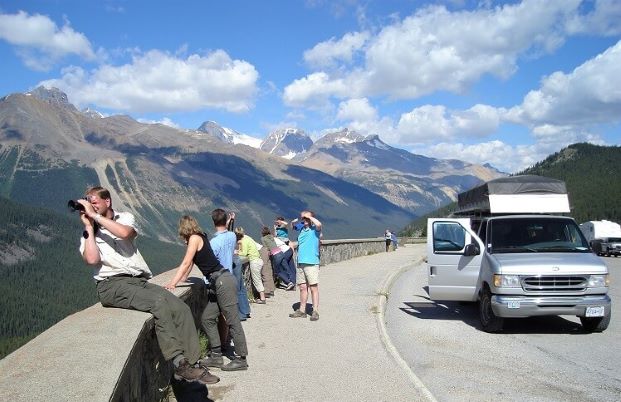
a small tour group along the Icefields Parkway
- You sacrifice some flexibility: you can’t go off by yourself, or do your own thing.
- Most agents sell standard itineraries that don’t take into account more varied interests.
- There are many places in Canada that are just as beautiful as the standard tourist highlights,
but are much less well known. You probably won’t see these when travelling with a set itinerary.
Some popular types of organized travel in Canada include Group Tours, Bus or Motor Coach Tours, Train Tours and Cruises.
A tailored itinerary in Canada
If you’re looking for personalized travel advice, you’ve come to the right place! You get the best of both worlds: my professional help, and the freedom to follow your own inclination.
I have almost a decade of experience as a tour guide in Canada, and would be happy to offer you my skilled professional services. I know all the best destinations, the best times to visit them, the best places to stay, the best routes to take – in short, everything you need to plan your Canadian adventure.
The advantages of booking a tailored itinerary:
- You decide when you want to travel in Canada, and where you want to go.
- You have all the flexibility you want, to follow the beat of your own drummer.
- You can include pre-booked events – such as a whale-watching trip, a bear-watching tour, a dog-sled adventure, a guided kayak trip, or a guided hiking excursion.
- You don’t have to do your own research, which saves you time and energy.
Travelling in Canada with all the comforts
If you like your travel experience to have a maximum of comfort, and a minimum of surprises or exertions, some ways offer more than others:
- Take a road trip in a motor home or RV.
You can even travel in a convoy guided by a tour director. This way of travel allows privacy during daytime and time to socialize at night. - Join a coach tour
- Enjoy a cruise
- Discover Canada by air
Travel in Canada more adventurously
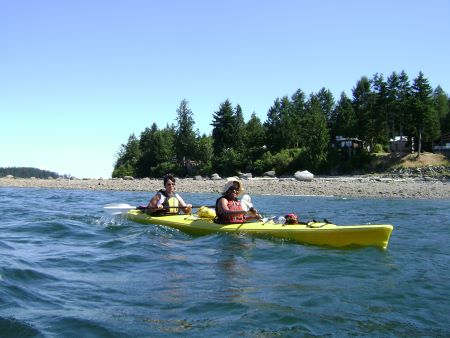
sea kayaking is quite an adventure!
If you have an independent streak, and like the idea of a more rugged travel experience, Canada offers many off-the-beaten path ways to appreciate the country:
- Drive a motor bike
- Book a flight on a float plane
- Use public transit
– take a ferry
– make a trip by bus or
– travel by train
If you’re a serious outdoor enthusiast, here are some ways to have an adventure vacation:
- Book a horse-trekking expedition
- Experience regions of the country by bicycle
- Get to know Canada’s waterways by canoe, white-water raft or enjoy a kayak vacation
- Take a hiking or backpacking excursion
- In winter, the most authentic Canadian experience is a dog-sledding outing.
You might like these

Train Travel in Canada
The coolest way to travel in Canada is by train. Discover several railroad companies that offer passenger train travel in Canada.
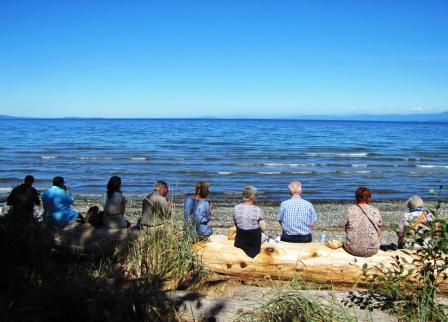
Canada Group Travel: five reasons to join a tour group
Canada group travel is the way to go! Group travel tours have some great advantages.

Coach Tours Canada
Coach tours are the most comfortable, economic and carbon friendly way to travel in Canada
How do people goods and ideas travel in canada
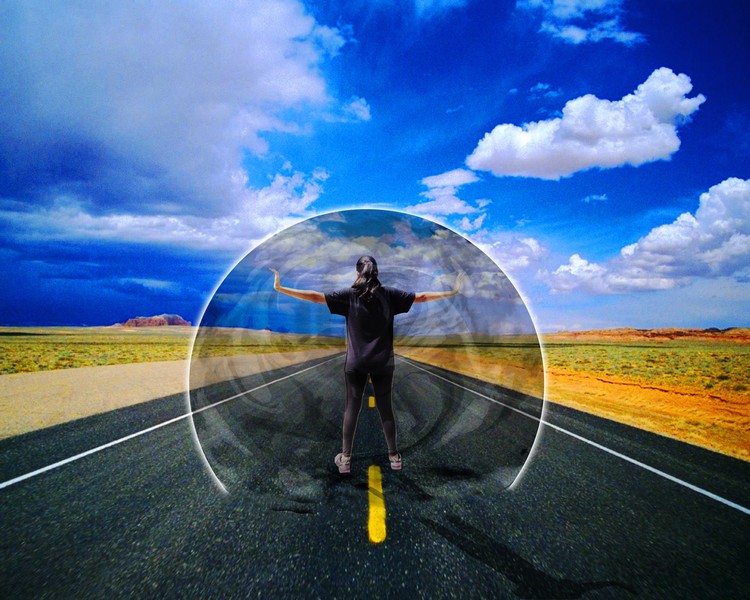
This unit of inquiry is not a recipe book but rather a launch pad to inspire new BIG IDEAS. We encourage you to use and/or modify one, or several of the BIG IDEAS below. Adapt it to the grade/ ability level of your students.
Enduring Understanding
The movement of goods and people between cities and countries has multiple causes and consequences on communities and societies as a whole.
Guiding Questions
How does the movement of goods and people relate to changes in a community and society? How does the movement of goods and people connect local communities and global economies? How does the movement of goods and people relate to tension in communities and society?
Mind Opening
Choose or devise practices to encourage students to be open to new experiences and ways of thinking in your classroom. For example, the MindUP in-school program.
Discovery & Inspiration:
Launch the Project
• Introduce the Theme: Present the Enduring Understanding and Guiding Questions using vocabulary that is appropriate for your grade level.
• About Vancouver Biennale: Play a short video.
• Create Project Space: Brainstorm ideas to make the project theme visual and visible using bulletin boards, and/or a project corner to share relevant materials and inquiry questions and processes.
Reference Resources:
• Introduction to Sculpture and Public Art Unit Plan for information on how art has evolved over time and the unique experience sculptures and/or public art brings.
• Vancouver Biennale 2014-2016 Exhibition Theme: Introduce the exhibition theme: Open Borders / Crossroads Vancouver
Other Resources
Covered in the Reference Material for Inquiry Challenges list of this unit plan
Learning to Learn:
Art Inquiry
• Make a visit to WOW Westminster and encourage students to freely explore and interact with the art pieces individually and in groups.
BIG IDEAS Anywhere educators: View WOW Westminster Guided Tour Video MUTE ON and encourage students to explore at different angles individually and in groups.
• This Art Inquiry process enables the students to practice observing, describing, interpreting, and sharing visual information and personal experiences.
• Use the Art Inquiry Worksheet (PDF) to guide and capture their ideas and impressions. Customize or create your own Art Inquiry Worksheet as appropriate for your project and class needs.
Shared Insights
• Sharing Art Inquiry Experience: Ask students to share the Art Inquiry Worksheet responses in class.
• View Guided Tour Video: View WOW Westminster Guided Tour Video again with SOUND ON.
• Significant Aspects of the Artist’s Life & Work : Using the following About Artist and Artwork (PDF), the teacher creates stations detailing the artist’s life and work. In small groups students rotate through these stations. Topics might include: (1) education and training; (2) life’s work; (2) materials and processes; (3) beliefs and values. At each station, students answer questions and/or complete tasks. For example, at the station “life’s work” students might plot the artist’s various installations on a map of the world.
• Artist Themes: The Movement of People & Goods – How is the movement of goods and people reflected in our everyday lives? As preliminary homework, students complete the Family History Worksheet.
1/ Students share their family history maps in groups of 5. These are posted on a bulletin board. Teacher leads a discussion around how the movement of ancestors is reflected in our current life through culture (different foods, religions, celebrations, traditions etc.).
2/ Students from a large circle around the room and look at the labels on a partner’s clothing to see where it was manufactured. Students share this information with the group.
3/ Teacher-led discussion: How do you think these items arrived in Canada?
4/ Teacher wrap-up: How might the movement of goods and people produce tension in communities or societies as a whole?
• Artist Themes: Movement & Tension – How does Resende’s work reflect movement and tension in society? Show students images of Resende’s work in locations throughout the world. Students brainstorm possible preliminary answers to this question. Teacher records these and posts them in a visible area of the classroom. Introduce the three guiding questions: (1) How does the movement of goods and people relate to changes in a community and society? (2) How does the movement goods and people connect local communities and global economies? and (3) How does the movement of goods and people relate to tension in communities and societies? Reconfirm that the purpose of this inquiry is to delve further into these questions and that answers and understandings are meant to evolve and change.
• Artist Themes: Shipping Containers – How does the movement of goods and people relate to Resende’s use of the shipping container? Play the following Ted-Ed Original (lessons that feature the words and ideas of educators brought to life by professional animators) of Sir Harold Evans, the author of They Made America, describing how frustration drove Malcom McLean, a small-town truck driver, to invent the shipping container. Containerization was born, and it transformed the modern global economy. Ask student to research the different types of containers and their uses. Two possible reference sites: Sea Box & Port Metro Vancouver. Teacher-led discussion: Why do you think Resende used shipping containers in his artwork?
Inquiry Challenges
• Movement & Tension: Cause & Consequence, The Cariboo Gold Rush – What were the causes and consequences of the Cariboo Gold Rush on New Westminster? How does this historical event reflect the themes of movement & tension in Resende’s work? During the Cariboo Gold Rush (1858) New Westminster was a major outfitting point for prospectors as all travel to the goldfield ports of Yale and Port Douglas was by steamboat or canoe up the Fraser River.
1/ Introduce/revisit the concept of Cause and Consequence.
2/ In groups, students investigate the consequences the unexpected number of people who arrived in 1858 and the effect had on New Westminster.
3/ Students are to come up with what they believe are 5 key causes and 5 key consequences of the Cariboo Gold Rush (see resource web sites below).
4/ Teacher leads the class through the ESP Conditions Gold Rush Chart. Ask students to assess to what extent individuals, groups, and social forces influenced the Cariboo Gold Rush using this Cause and Consequence Template as a guide
5/ Groups also answer the following questions at the end of their presentation to the class: What were the short-term consequences of the Gold Rush on New West? What were the long-term consequences? Were there any unintended consequences? If so, what were they? What significance does the Gold Rush have in New West today?
• Movement of People and Tension: Cause & Consequence, The Cariboo Gold Rush & First Nations
Part I – What impact did the Cariboo Gold rush have on First Nations? In discussions of the gold rush and the building of the Cariboo Wagon Road, the First Nations of the are often overlooked. The Wagon Road passed through the territories of several distinct groups, from roughly south to north the Nicola, Thompson, Shuswap, Chilcotin, and Carrier, The Qayqayt First Nation (qiqéyt) (pronounced Key-Kayt), also known as the New Westminster Indian Band, is one of the smallest First Nations in Canada and the only one registered without a land base. In groups, students fill out the final portion of their ESP Conditions Gold Rush Chart using the web resources below. Teacher leads a class through a discussion of the following questions: What were the short-term consequences of the Gold Rush on First Nations? What were the long-term consequences? Were there any unintended consequences? If so, what were they? What significance does the Gold Rush have for First Nations today?
Helpful Resources:
Novel: The Golden Rose, Dayle Campbell Gaetz, 2003
Book: British Columbia: 1847-1871 Gold & Colonists, G.P.V. Akrigg & Helen Akrigg, 1977
First Nations:
Fisher, R. (1971-72, Winter). Joseph Trutch and Indian Land Policy. BC Studies.
Ormsby, M. (1996). A Pioneer Gentlewoman in British Columbia: the recollections of Susan Allison. University of BC Press.
Yabsley, C. J. (1991, Spring). Conspiracy of Legislation: The Suppression of Indian Rights in Canada. BC Studies.
• Movement of People and Tension: Cause & Consequence, The Cariboo Gold Rush & First Nations –
Part II – How did Canadian settlers view First Nations during the Cariboo Gold Rush? How can we evaluate these values today?
1/ Divide students into small groups (3-4 students) each group looks at one of the following documents (modified, highlighted or condensed to their main ideas): (1) Joseph Trutch and Indian Land Policy: by Robin Fischer (2) Conspiracy of Legislation: The Suppression of Indian Rights in Canada: Chief Joe Mathias and Gary R. Yabsley; (3) A Pioneer Gentlewoman in British Columbia: The Recollections of Susan Allison: Ed. Margaret Ormsby. Each article or set of documents discusses some of the groups living around the Fraser around the years of the Gold Rush.
2/ Introduce/ revisit the concept of Historical Evidence.
3/ Students may fill out the following Historical Thinking Evidence Worksheet while reading the documents.
4/ Introduce/ revisit the concept of Historical Perspective and the Ethical Dimension. Questions: What tensions do these documents reflect? What information would you need to know in order to evaluate the actions referenced in these documents? Can these actions be justified? Why, why not? What criteria we use when evaluating past and current events? Should our current values be applied to past events? Why, why not?
• Movement of Goods: Cause & Consequence & The Cariboo Gold Rush– What impact did the Cariboo Gold Rush have on British Columbia? How does this historical event reflect the themes of movement & tension in Resende’s work?
1/ Students assess how the gold rush changed primary, secondary and tertiary industry in British Columbia during this time period.
2/ In small groups students are assigned one of the three industry categories (primary, secondary or tertiary).
3/ Using chart paper, have students define the category they are working on and state examples of that particular type of industry Students then brainstorm ideas of what changes occurred during the Gold Rush in their assigned category (see resource web sites list below).
4/ Groups share with the whole class.
5/ Compare ideas and collaborate on a common chart.
• Continuity & Change: New Westminster & the Fraser River – How do historical photographs reflect the themes of movement and tension in Resende’s work?
1/ Introduce/revisit the concept of Continuity & Change. Using the Historical Photo Databas of the New Westminster Public Library , have students search for historical images of the area where New Westminster Pier Park is located (along the Fraser River).
2/ Students select three images of the area from different historical time periods and document dates and citations and save them.
3/ They then find three more recent images (one of which should be close as close as possible to the current year) and do the same.
4/ Groups collate photographs and text by using a digital timeline generator like Capzles* or by producing timelines on larges sheets of paper.
5/ Groups answer to the following questions as part of their work: What does the story of your timeline show? What has changed the most in the area around New Westminster Pier? What has changed the least? What are some of the turning points? Were there times of more continuity or more change? How could your timeline be divided into chunks or periods? What events might be most important for New Westminster’s citizens? What events might be most important for industry owners? What clues do these photographs give us about how transportation and infrastructure have changed and/or impacted the community over time?
6/ After posting the photographic timelines in the classroom, teacher can challenge the students to answer the question: During the passing of time between the photographs, do you think the area around New Westminster Pier park or improved or declined? Students are asked to take into account economic change, social and cultural change, and environmental change.
7/ Visiting the Artwork: Visit Resende’s installation in New Westminster and encourage students to freely explore and interact with the artwork when students visit the artwork. Consider having them take their own digital images using their smart phones and add them to these timelines OR BIG IDEAS Anywhere educators: View the Guided Tour Video (Available Soon) MUTE ON and encourage students to explore at different angles individually and in groups.
Culminating question: How has Resende’s work transformed the landscape in New Westminster?
*(Capzles is a free iTunes app accessible from any computer. It allows users to tell a story using pictures, video clips, audio tracks and text. Users can place this media, called “moments”, together chronologically in a timeline. The result is called a “capzle”. Moments can be viewed individually, or all can be viewed in progression. Capzles can be shared with friends by sending an email link.)
Tension, Controversy & Debate – How does public art incite controversy? How does Resende’s work reflect and also incite it? Teacher reads the April 30, 2014 article from New Westminster Newsleader, aloud to the class surrounding the “Wow Factor” controversy over Resende’s New Westminster artwork. In small groups students are asked to express their opinion on the issue. Do they agree, strongly agree, disagree or strongly disagree that Resende’s work should be funded and placed New Westminster Pier Park? The entire class then engages in a Four Corners Activity
Reflection
• Teacher and students can reflect on their entire learning process by revisiting the Enduring Understanding and Guiding Questions.
• How did the unit of study open inquiry, create cross–curricular learning opportunities and/or apply learning to real life situations? Has this unit of inquiry changed your opinions, values and worldview? In what ways, if any, has it helped you grow as a learner?
Ideas for Cross-Curricular Access
• Mathematics, Science & Arts Education: Designing a Cargo Container Activity – How can you design and construct a cargo container that will support the most weight?
1/ Cargo container model must be designed after a cargo container type and is to have an assigned scale.
2/ Teacher uses Designing a Cargo Container Worksheet to guide students through this exercise.
3/ Introduction and review instructions to groups of tow.
4/ Using computer, each group is to review cargo container types, choose a container type to model, assign a scale for their container, sketch their container design, and begin construction of their container model.
5/ Reviews progress and continue with the construction of their container model.
6/ Each group to destructively test the container model in front of the class and calculate its efficiency of design.
7/ Complete the worksheet.
• Language Arts – Expressing a Persuasive Argument About Public Art:
Can writing change a person’s opinions and/or worldview? Perhaps one of the best and most widely recognized examples of persuasive writing in action is the classic editorial.
1/ Inquiry into what students know: What is an editorial? Have you ever read one? What is the purpose of an editorial?
2/ Teacher may show NY Times editorial page editor Andrew Rosenthal’s Brief Video and give students his 7 Pointers Summary (Word).
3/ Teacher review the controversy over Resende’s work and reads them a selected editorial from the controversy (see April 30, 2014 article from New Westminster Newsleader)
4/ Students complete Part 1 of the Persuasive Writing/ Editorial- Format Worksheet (PDF) in pairs.
5/ Students use Part II of the Persuasive Writing/ Editorial- Format Worksheet (PDF) as a guide to draft their own editorials on Street Art.
6/ Drafts are peer edited to revise ideas, organization, voice, word, choice and sentence fluency.
7/ Editorials may be read aloud and/ or posted to classroom blog.
8/ Students may comment on the editorials or responses to these editorials on the blog.
Credits
Written by: Stephanie Anderson Redmond, B.A.; B.Ed.; M.Ed.; Ph.D. Student, Department of Curriculum and Pedagogy, UBC
15 Things To Know Before Traveling To Canada
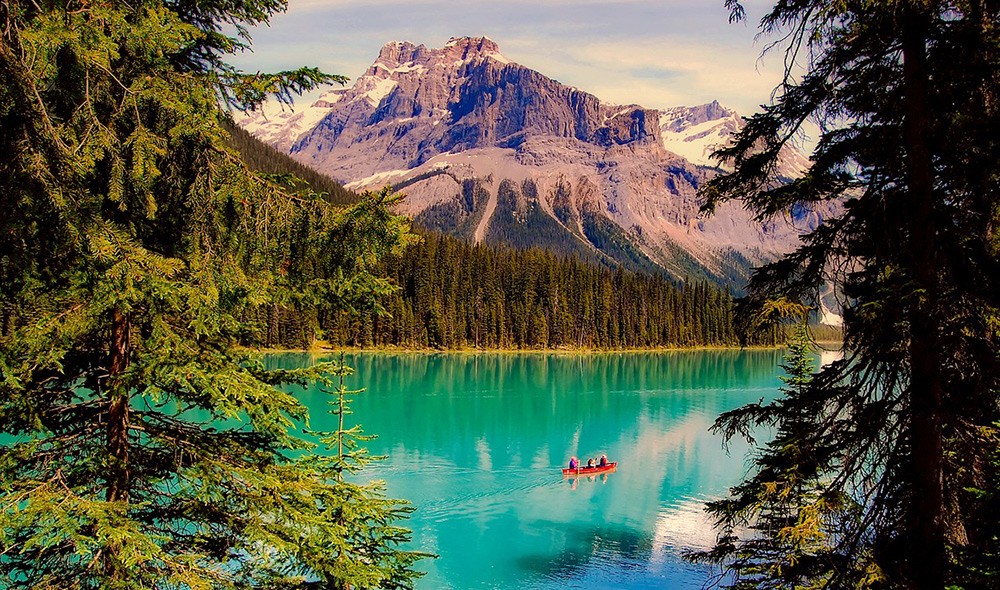
Thinking about going to Canada in the near future? With bustling cities and wondrous national parks, why wouldn’t anyone want to take in everything this country has to offer!
Canada might share a border with the USA but in many ways Canada is very different from its neighbor.
So, before you plan your trip to Canada there are a few things you should know.
15 Things to Know Before Traveling to Canada
1. Canada is a Big Country!

In fact, Canada is the second-largest country in the world, right after Russia.
So, when you do go to Canada, don’t expect to be able to cover most of the country in just a few weeks. Canada is huge and traveling from one city to the next means traveling long distances.
If you only have a limited amount of time you are better off choosing one or two provinces of Canada and focusing on all the things there are to see there.
Also keep in mind that Canadian cities are very spread out.
So when you are booking a hotel or other accommodation that seems to be close to the main sights or a bus or train station, double-check the distances.
And yes, a hotel in one of the suburbs might be much cheaper, but keep in mind that those suburbs often feel like a separate city with their own shopping malls, parks, supermarkets, etc. Commuting from there to the main sights can be a pain and no, you definitely won’t be able to walk there like you might have gotten used to in many European cities.
Just to emphasize how big Canada really is: the country spans 6 time zones!
Canada is made up of 10 provinces and three territories and if you want to see a good chunk of it during your trip I would recommend renting a car. There are some scenic train routes or you can go on an organized tour, but in general, a car will get you the furthest.
Canada Fun Fact: Canada has the largest coastline in the world!
2. Be Prepared for Canada’s Weather
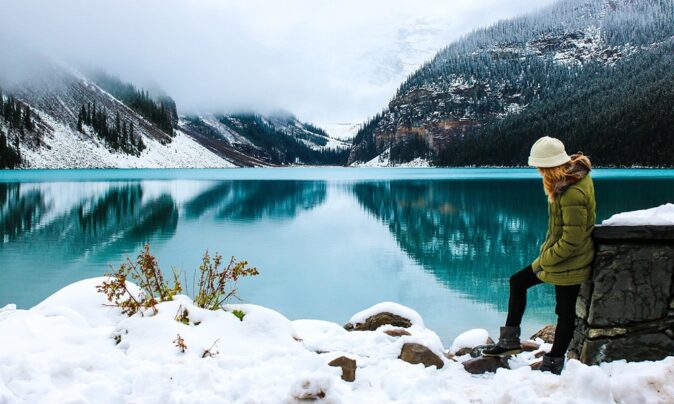
The most important packing tip for Canada: bring layers!
One of the important things to know before going to Canada is that even if you are visiting Canada in summer it can get chilly at night in the mountains. And the weather just varies a lot from place to place.
The British Columbia Coast (Canada’s western coastline) has milder temperatures in winter but if you are anywhere else in Canada in winter, expect it to get cold… Very cold! Bring a warm woolen hat (Canadians call it a toque), thick gloves and a scarf to wrap around your face.
Canada’s lowest recorded temperature was -81.4 degrees Fahrenheit (-63 C) in 1947!
Canada Fun Fact: In Newfoundland, Canada, the Atlantic Ocean sometimes freezes so people play hockey on it!
3. Canada Has Two Official Languages
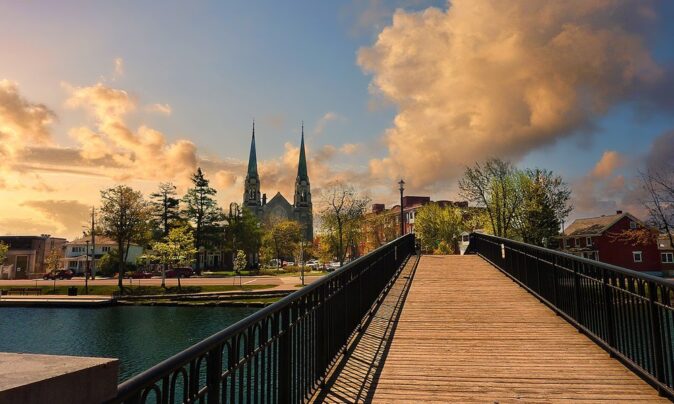
A majority of Canadians speak English as their first language, but French, Canada’s second official language, is the mother tongue of about 20% of the Canadian population.
And with Canada being such a multicultural society you will find different levels of proficiency in those languages, many different accents, and numerous other languages spoken.
French is the dominant language in the province of Quebec. But, the Quebecois twang and slang is a world away from the Parisian French you may have learnt in school.
4. Tipping in Canada

Tipping in Canada is similar to tipping in the USA.
When you are receiving services from waiters, hairdressers, cab drivers, hotel employees, and others, you are expected to give a tip.
Although tipping isn’t mandatory, in most cases a tip in the range of 15% to 20% is the standard.
5. Be Prepared to Have Sales Tax Added to Your Bills

Canada adds a federal sales tax to all goods and services. And on top of that most provinces also have their own tax.
This means that, depending on where you are in Canada, your bill could come with up to about 15% taxes.
So when you buy something in a store, the price you see on the label is not the final price. But also expect these taxes to be added to your restaurant bills, hotel bills, etc.
Just like the Americans, Canadians love their promotions, sales, and special offers. Therefore always compare prices before you buy! For example, gas prices can vary significantly from station to station and they change almost daily.
Note: There once was a tax refund program for visitors. This program, however, was dropped in 2007, so the taxes you pay while you’re in Canada stay in Canada.
6. Canadians are Polite

Canadians have a reputation for being polite. They generally behave very well in public and anything considered “disruptive” or “offensive” is frowned upon.
Cutting in line, making a scene, catcalling, loitering, littering, being drunk in public… just don’t do it anywhere, but definitely not in Canada!
Canadians are known for their tolerance and are very nonconfrontational. To some, they might come across as somewhat reserved and they will say sorry even if there is absolutely no need to apologize for anything!
7. You Can Expect Good Customer Service in Canada

Similar to the USA Canada is a consumer society and that does mean that the customer is normally king.
Most stores open seven days a week and close late at night. Restaurants cater to every possible diet and waiters tend to be friendly and attentive.
There are toll-free numbers to talk to customer service representatives and whatever service you need will usually work just fine.
8. Driving in Canada

Especially when you drive to Canada from the USA it’s good to know that speed limits are different in Canada. So before you start driving, check what the local speed limits are!
Like in most countries mobile phones must be used hands-free when driving and in Canada it is also illegal to smoke in a car if you are with a minor.
Driving conditions can get extremely hazardous in winter. Make sure you have a charged mobile phone and an emergency kit when you head out in snowy weather.
And if your car isn’t ready for winter driving, consider renting a car that is better equipped.
Canada Fun fact: Canada has fewer people in its entire country than Tokyo has in its metropolitan area!
9. You Will Need Health Insurance

Canada might be well known for its excellent healthcare system, but that’s only for Canadians.
If you get injured while visiting Canada and don’t have adequate health insurance you can be presented with huge medical bills.
So before you travel to Canada make sure you have travel insurance that covers any medical expenses in Canada!
10. The Legal Drinking Age in Canada is 18 or 19

Depending on the province, the legal drinking age in Canada is either 18 or 19.
The drinking age also applies to buying liquor and beer, which in most parts of Canada is at specially designated liquor and beer stores, not in grocery or convenience stores.
Because the legal drinking age in Canada is lower than in the USA you will find a lot of young Americans just across the border looking for a party.
11. Make Sure You Have The Right Travel Documents

Unless you are a US citizen you will normally need either a visa or an Electronic Travel Authorization (ETA) to enter Canada. What you need depends on what passport you hold so make sure to check this long before your travel date.
A Canada ETA is mandatory for all visa-free nationals except Americans. You will need to get this before you board your flight to Canada.
Getting your ETA is a simple online process through which takes only a few minutes to complete.
And if you are going to Canada overland from the USA, check this website about Canada-US border crossing requirements.
12. Emergency Information

Hopefully you won’t need this, but it’s definitely one of the things to know before going to Canada.
The phone number for contacting emergency services, including the police, medical services, and firefighters in Canada is 911.
13. Kilometers, Celsius and Liters

Unlike neighboring USA, Canadians use the metric system. Well, in theory.
In practice, it’s a bit of a mix. Distance and speed you will see posted in kilometers, but if you ask a Canadian how tall he is he’ll answer in feet and inches. And his weight, if he’ll tell you, will be in pounds.
For the weather Canadians use Celsius but when it comes to baking they tend to switch to Fahrenheit.
And if you are driving and need to stop for gas, keep in mind that the prices are per liter, not per gallon.
14. Tim Hortons Is a Must-Visit

Tim Hortons is an institution in Canada and you simply can’t miss it. That is, because it’s everywhere!
Nearly every town in Canada, no matter how small, has a Tim Hortons. It’s a coffee, sandwich and donut shop chain, named after a hockey player.
If you are looking for a cheap coffee or a snack, go to your nearest ‘Timmies’ and skip the Starbucks!
Canadians either love or hate Tim Hortons but as a traveler stop there at least once to form your own opinion.
15. Explore Canada’s Nature!

Yes, Canada has cool, modern and popular cities such as Toronto, Vancouver, and Montreal. With lots of culture, good food and plenty of things to do they make for good destinations, but Canada’s true beauty is outside of its cities.
Because of Canada’s size and relatively small population, most of the country is wild and unspoilt.
Canada Fun fact: Canada has more lakes than the rest of the world’s lakes combined.
There are huge areas of pristine, unspoiled wilderness waiting to be explored when you go to Canada.
Whether it is tramping across a glacier in the Rocky Mountains, hiking through coastal rainforests on Vancouver island or canoeing through Ontario’s lakes – Canada’s great outdoors can’t be missed!
If you love outdoor sports such as hiking, camping, canoeing, skiing, fishing, bird watching, etc. you will be in your element in Canada.
Canada has so many national parks that offer great activities and incredible views. So at least try to fit in one or two of them when traveling to Canada!
And there you have it, 15 useful things to know before traveling to Canada.
I hope you enjoy your time in Canada and get to see as much as you can of this large and beautiful country!
Also Read:
Like this article about things to know before traveling to Canada? Pin it!

This blog post about things to know before traveling to Canada contains affiliate links. I may receive a commission for purchases made through these links, at no additional cost to you.
Author: Sanne Wesselman
A traveler, wanderer, digital nomad, and entrepreneur. Owner of marketing company A to Z Marketing.
I spend most of my time living and working abroad and use this website to share “the good, the bad and the ugly” of traveling and living abroad. Visit the About Me page for more info.
5 thoughts on “15 Things To Know Before Traveling To Canada”
After reading this article, I can boldly say Canada is arguably the best country in the world. Scenery, politeness, education, healthcare, security or safety, peacefulness, etc. I need to visit Canada. Kudos to you guys.
Looking for a great place to vacation for my 53 third birthday. Niagara falls is my dream come destination. My birthday is June 7, . I’m ready to get out and enjoy myself. Thanks
I love this. As a Canadian who’s travelled abroad, this covered the things I was confused about in other countries (namely backpacking through Europe 12 years ago) … and our politeness level literally changes depending on the city, too! we’re flexible like that
Hi Sanne, it’s a helpful article about Canada thank you for your effort. And I really like Tim Hortons
Please add one more item. No guns allowed to take with you across the border into Canada!
Leave a Comment Cancel reply
Search
Affiliate Disclaimer
Some links on this website are affiliate links. We may receive a commission for purchases made through these links, at no additional cost to you.
Source https://www.tourguidecanada.com/travel-in-Canada.html
Source https://www.vancouverbiennale.com/unit-plans/movement-of-goods-and-people/
Source https://www.spendlifetraveling.com/things-to-know-before-traveling-to-canada/